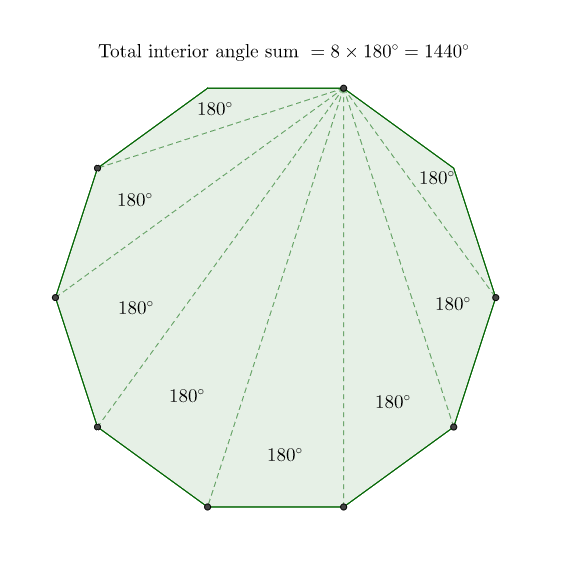General Polygons - Angles
Contents
General Polygons
A simple closed figure made up of only line segments is called a polygon. We generally classify polygons according to the number of sides (or vertices) they have. For example, a polygon with 3 sides or vertices is called a triangle; similarly, a polygon with 4 sides or vertices is called a quadrilateral.
A regular polygon is both equiangular and equilateral. For example, a square has sides of equal length and angles of equal measure, and hence it's a regular polygon unlike a rectangle which does not have all sides equal. Similarly, a regular pentagon is a polygon which has all 5 sides equal and has all angles equal.
Angle Sum Property
You must be familiar with the angle sum property of a triangle which states that the sum of the measurements of the three interior angles of a triangle is \(180^\circ\).
Proof without Words
The sum of the measurements of the three interior angles of a triangle is 180º.

Here's a short diagramatic proof for the above mentioned result:
Now if we consider a quadrilateral, it can be divided into 2 triangles; thus the sum of the measures of the four angles of a quadrilateral is \(360^\circ\). Similarly, any \(n\)-sided polygon can be divided into triangles.


Now, since it can be a tedious job to divide a polygon into many triangles and then calculate the sum of all its angles, we can find the sum \(S\) of all the interior angles of any polygon with \(n\) sides by the formula
\[S = (n-2) \times 180^\circ.\]
We shall use induction in this proof.
The base case of \(n=3\) is true as the sum of the interior angles of a triangle is \(180^\circ\) or \(\pi\).
Then, assume that the statement is true for \(P_k\) \((\)here \(P_k\) denotes a \(k\)-sided polygon\().\)
Now, consider \(P_{k+1}\) with vertices \(A_1, A_2, \ldots A_k, A_{k+1}\).
Split this polygon into two parts by joining \(A_1\) and \(A_k\), then\[ \begin{align} (\text{Sum of interior angles of } P_{k+1}) &= (\text{Sum of interior angles of } A_1 A_2 \ldots A_{k-1} A_k) + (\text{Sum of interior angles of } A_1 A_k A_{k+1}) \\ &= (k-2)\times 180 ^\circ + 180^\circ \\ &= \big((k+1)-2\big) \times 180^\circ. \end{align} \]
This completes the inductive step. \(_\square\)

What is the sum of all 8 yellow angles?
 If we want to exactly cover a regular octagon with triangles (of any kind), what is the least number of triangles that we must use?
If we want to exactly cover a regular octagon with triangles (of any kind), what is the least number of triangles that we must use?
A polygon has 20 sides.
Find the sum of interior angles of the polygon (in degrees).
Sameer has some geometry homework and is stuck with a question. The question says that the sum of the interior angles of a polygon doesn't exceed 2014 degrees.
What is the maximum possible number of sides of the polygon?
Sum of the Exterior Angles of a Polygon
On many occasions a knowledge of exterior angles may throw light on the nature of interior angles and sides.
The sum of the measures of the external angles of any polygon is \(360^\circ\). This is true whatever the number of sides of the polygon is.
Label the interior angles of \(P_n\) as \(\text{Int}\angle_1, \text{Int}\angle_2, \ldots, \text{Int}\angle_{n-1}, \text{Int}\angle_n\) and the corresponding exterior angles as \(\text{Ext}\angle_1, \text{Ext}\angle_2, \ldots, \text{Ext}\angle_{n-1}, \text{Ext}\angle_n\).
Note that \(\text{Int}\angle_i + \text{Ext}\angle_i = 180^\circ, \quad i=1,2, \ldots, n-1,n. \)
Then
\[ \begin{align} (\text{Sum of all exterior angles}) &=n \times 180^\circ - (\text{Sum of all interior angles}) \\ &= n \times 180^\circ - (n-2) \times 180^\circ \\ &= 360^\circ.\ _\square \end{align} \]
Here's a visual representation of this proof done with the case of a regular decagon.


Another short picture-proof without the need of any explanations would be this.

Find the number of sides of a polygon each of whose exterior angles has a measure of \(20^\circ\).
Total measure of all exterior angles = \(360^\circ.\)
Measure of each exterior angle = \(20^\circ.\)
Therefore, the number of exterior angles = \( \frac{360^\circ}{20^\circ}\) = \(18.\)Thus, the polygon has 18 sides. \( _\square \)

The interior angles of a convex polygon are in arithmetic progression. The smallest angle is \(120^\circ\) and the common difference is \(5^\circ\).
Find the number of sides of the polygon.
The interior angle of a regular polygon is 30 degrees less than six times the exterior angle.
How many sides does the polygon have?
 A polygon has \( n \) sides. Two of its exterior angles are 72 degrees and 35 degrees, while the remaining exterior angles are each equal to 23 degrees.
A polygon has \( n \) sides. Two of its exterior angles are 72 degrees and 35 degrees, while the remaining exterior angles are each equal to 23 degrees.
Find the value of \( n \).
